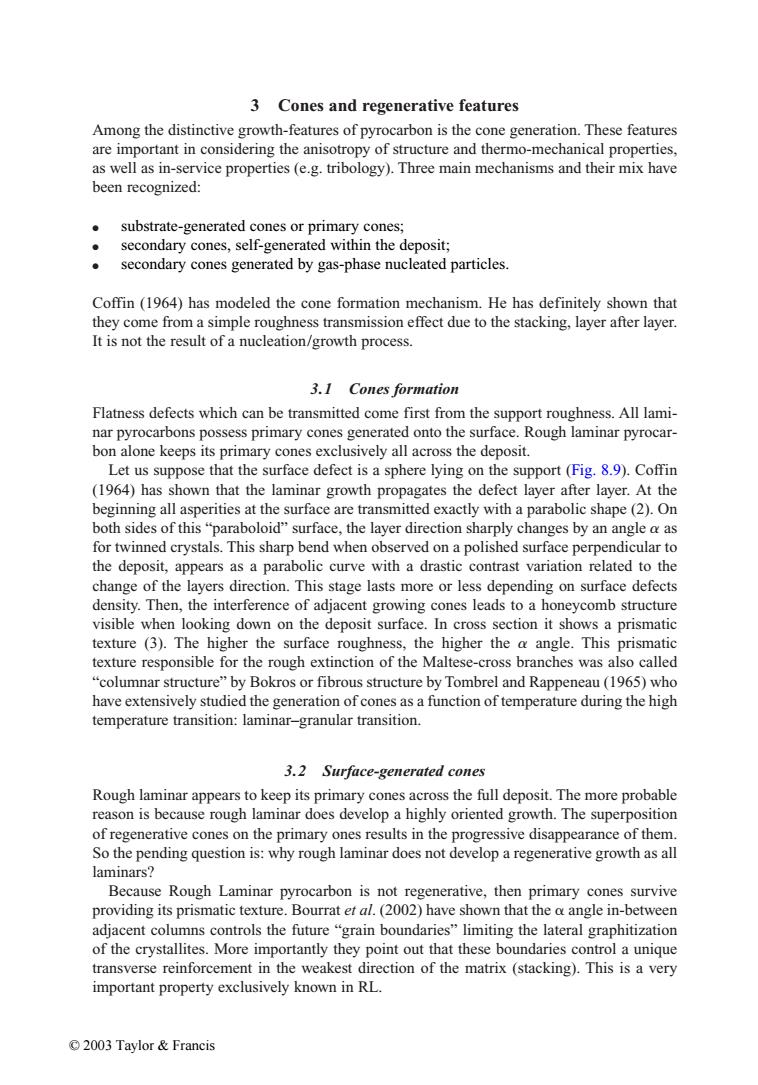正在加载图片...

3 Cones and regenerative features Among the distinctive growth-features of pyrocarbon is the cone generation.These features are important in considering the anisotropy of structure and thermo-mechanical properties, as well as in-service properties (e.g.tribology).Three main mechanisms and their mix have been recognized: substrate-generated cones or primary cones; secondary cones,self-generated within the deposit; secondary cones generated by gas-phase nucleated particles. Coffin (1964)has modeled the cone formation mechanism.He has definitely shown that they come from a simple roughness transmission effect due to the stacking,layer after layer. It is not the result of a nucleation/growth process. 3.1 Cones formation Flatness defects which can be transmitted come first from the support roughness.All lami- nar pyrocarbons possess primary cones generated onto the surface.Rough laminar pyrocar- bon alone keeps its primary cones exclusively all across the deposit. Let us suppose that the surface defect is a sphere lying on the support(Fig.8.9).Coffin (1964)has shown that the laminar growth propagates the defect layer after layer.At the beginning all asperities at the surface are transmitted exactly with a parabolic shape(2).On both sides of this "paraboloid"surface,the layer direction sharply changes by an angle a as for twinned crystals.This sharp bend when observed on a polished surface perpendicular to the deposit,appears as a parabolic curve with a drastic contrast variation related to the change of the layers direction.This stage lasts more or less depending on surface defects density.Then,the interference of adjacent growing cones leads to a honeycomb structure visible when looking down on the deposit surface.In cross section it shows a prismatic texture (3).The higher the surface roughness,the higher the a angle.This prismatic texture responsible for the rough extinction of the Maltese-cross branches was also called "columnar structure"by Bokros or fibrous structure by Tombrel and Rappeneau(1965)who have extensively studied the generation of cones as a function of temperature during the high temperature transition:laminar-granular transition. 3.2 Surface-generated cones Rough laminar appears to keep its primary cones across the full deposit.The more probable reason is because rough laminar does develop a highly oriented growth.The superposition of regenerative cones on the primary ones results in the progressive disappearance of them. So the pending question is:why rough laminar does not develop a regenerative growth as all laminars? Because Rough Laminar pyrocarbon is not regenerative,then primary cones survive providing its prismatic texture.Bourrat et al.(2002)have shown that the o angle in-between adjacent columns controls the future "grain boundaries"limiting the lateral graphitization of the crystallites.More importantly they point out that these boundaries control a unique transverse reinforcement in the weakest direction of the matrix (stacking).This is a very important property exclusively known in RL. ©2003 Taylor&Francis3 Cones and regenerative features Among the distinctive growth-features of pyrocarbon is the cone generation. These features are important in considering the anisotropy of structure and thermo-mechanical properties, as well as in-service properties (e.g. tribology). Three main mechanisms and their mix have been recognized: ● substrate-generated cones or primary cones; ● secondary cones, self-generated within the deposit; ● secondary cones generated by gas-phase nucleated particles. Coffin (1964) has modeled the cone formation mechanism. He has definitely shown that they come from a simple roughness transmission effect due to the stacking, layer after layer. It is not the result of a nucleation/growth process. 3.1 Cones formation Flatness defects which can be transmitted come first from the support roughness. All laminar pyrocarbons possess primary cones generated onto the surface. Rough laminar pyrocarbon alone keeps its primary cones exclusively all across the deposit. Let us suppose that the surface defect is a sphere lying on the support (Fig. 8.9). Coffin (1964) has shown that the laminar growth propagates the defect layer after layer. At the beginning all asperities at the surface are transmitted exactly with a parabolic shape (2). On both sides of this “paraboloid” surface, the layer direction sharply changes by an angle as for twinned crystals. This sharp bend when observed on a polished surface perpendicular to the deposit, appears as a parabolic curve with a drastic contrast variation related to the change of the layers direction. This stage lasts more or less depending on surface defects density. Then, the interference of adjacent growing cones leads to a honeycomb structure visible when looking down on the deposit surface. In cross section it shows a prismatic texture (3). The higher the surface roughness, the higher the angle. This prismatic texture responsible for the rough extinction of the Maltese-cross branches was also called “columnar structure” by Bokros or fibrous structure by Tombrel and Rappeneau (1965) who have extensively studied the generation of cones as a function of temperature during the high temperature transition: laminar–granular transition. 3.2 Surface-generated cones Rough laminar appears to keep its primary cones across the full deposit. The more probable reason is because rough laminar does develop a highly oriented growth. The superposition of regenerative cones on the primary ones results in the progressive disappearance of them. So the pending question is: why rough laminar does not develop a regenerative growth as all laminars? Because Rough Laminar pyrocarbon is not regenerative, then primary cones survive providing its prismatic texture. Bourrat et al. (2002) have shown that the angle in-between adjacent columns controls the future “grain boundaries” limiting the lateral graphitization of the crystallites. More importantly they point out that these boundaries control a unique transverse reinforcement in the weakest direction of the matrix (stacking). This is a very important property exclusively known in RL. © 2003 Taylor & Francis